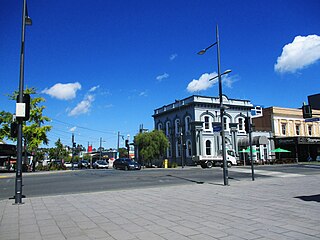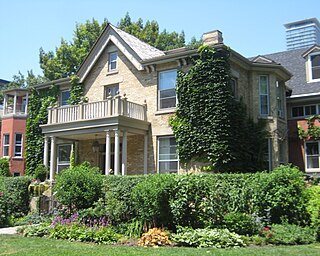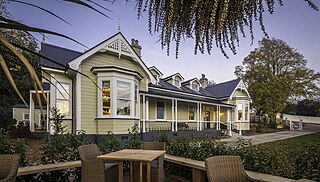
Collingwood is a town in Simcoe County, Ontario, Canada. It is situated on Nottawasaga Bay at the southern point of Georgian Bay. Collingwood is well known as a tourist destination, for its skiing in the winter, and limestone caves along the Niagara Escarpment in the summer.

Collingwood is a town in the north-west corner of the South Island of New Zealand along Golden Bay / Mohua. The town is an ecotourism destination due to its proximity to Kahurangi National Park and Farewell Spit Nature Reserve.

Simcoe—Grey is a federal electoral district in Ontario, Canada, that has been represented in the House of Commons of Canada since 1997.
Palgrave is a Compact Rural Community and unincorporated place in the Town of Caledon, Regional Municipality of Peel in the Greater Toronto Area of Ontario, Canada. It is about 10 kilometres (6.2 mi) north of Bolton and about 50 kilometres (31 mi) northwest of Toronto. Palgrave is located east of Orangeville, south of Alliston, west of Newmarket and north of Brampton. As

Hurontario Street is a roadway running in Ontario, Canada between Lake Ontario at Mississauga and Lake Huron's Georgian Bay at Collingwood. Within Peel Region, it is a major urban thoroughfare within the cities of Mississauga and Brampton, which serves as the divide from which cross-streets are split into East and West, except at its foot in the historic Mississauga neighbourhood of Port Credit. Farther north, with the exception of the section through Simcoe County, where it forms the 8th Concession, it is the meridian for the rural municipalities it passes through. In Dufferin County, for instance, parallel roads are labelled as EHS or WHS for East of Hurontario Street.

The Southgate–Lewis House is located one mile east of the Texas State Capitol in Austin, Texas, at 1501 East 12th Street. The house was constructed in 1888, and now stands as an African-American historical landmark. It is also a repository for African-American History and Culture in the region of east Austin, which historically became an African-American neighborhood. The City of Austin has now declared this region to be "Austin's Black Cultural District." The Southgate–Lewis House is located in the center of the "African American Cultural Heritage District".

Hamilton Central is the central business district of Hamilton, New Zealand. It is located on the western banks of the Waikato River.

Dundas Valley Conservation Area is located on the Niagara Escarpment in Dundas, Ontario, a constituent community of Hamilton, Ontario, and is owned and operated by the Hamilton Conservation Authority. Its 40-kilometre trail system provides a connection to the Bruce Trail. The area contains a trailhead of the Hamilton-Brantford-Cambridge Trails, Canada's first fully developed interurban multi-use trail system, which is a part of the Trans Canada Trail.

The Heritage Trust of Nova Scotia is a non-profit society dedicated to the advocacy for and conservation of Nova Scotia's architectural and cultural heritage. It was founded in 1959, "in response to the proposed demolition of Enos Collins's Halifax House Gorsebrook," a Georgian-style home that once stood on the present site of Saint Mary's University hockey rink. The Trust has advocated for and assisted in the conservation of numerous heritage buildings and districts in Nova Scotia. Notable examples include The Carleton, Morris House, and Historic Properties.
Missing middle housing describes a range of multi-family or clustered housing types that are compatible in scale with single-family or transitional neighborhoods. Missing middle housing is intended to meet the demand for walkable neighborhoods, respond to changing demographics, and provide housing at different price points. The term "missing middle" is meant to describe housing types that were common in the pre-WWII United States such as duplexes, rowhomes, and courtyard apartments but are now less common and, therefore, "missing". Rather than focusing on the number of units in a structure, missing middle housing emphasizes scale and heights that are appropriate for single-family neighborhoods or transitional neighborhoods. After the introduction of the term in 2010, the concept has been applied in the United States, Canada, and Australia.

The Union Building is an older building in Toronto that has been described as an "architectural gem". When it was built, in 1908, on the Northwest corner of King and Simcoe streets, it was directly across from the palatial official residence of the Lieutenant Governor of Ontario.

The Kitchener Farmer's Market is one of the oldest continuous local farmer's markets in Canada. The market is located in Kitchener, Ontario and reflects the continued relationship of Kitchener with the Mennonite community and farmers that continues to exist in the area.

Berkeley House was a prominent house in York, Upper Canada. It was the home of two Clerks of Upper Canada's Privy Council – John Small, and his son Charles Coxwell Small. Upper Canada's first small Parliament buildings were built next door to Berkeley House. Small is reported to have hosted meetings of the province's Executive Committee in his home.

The Paul Kane House is a heritage structure in Toronto, Ontario, Canada. Paul Kane, an important early Canadian artist, purchased the property in 1853 and built a cottage on the site.

The Glenn Building is a historic building on Marietta Street in downtown Atlanta, Georgia, United States. Built in 1923 as an office building, the building was converted to a boutique hotel in 2006 and added to the National Register of Historic Places in 2008.

The town of Collingwood, Ontario, was the first municipality in Canada to have a heritage conservation district included on the Canadian Register of Historic Places.
The Lester B. Pearson Civic Centre was located in Elliot Lake, Ontario, Canada, It was a community arts and theatre center that also housed community offices. Locals commonly refer to it as “the Civic Centre.” The building originally housed the Nordic Hotel, built when the town was first opening its mines. Later, it became the site of many community events and the location of many arts clubs, as well as the Welcome Centre, the Art Gallery, and the Elliot Lake Nuclear and Mining Museum. Following its collapse in February 2019 the City of Elliot Lake has been left without an arts and theatre center.

Hulbert House is a 19th-century Victorian villa on Ballarat St. in Queenstown, New Zealand, overlooking Lake Wakatipu. The house has six suites, each named after notable individuals.

















